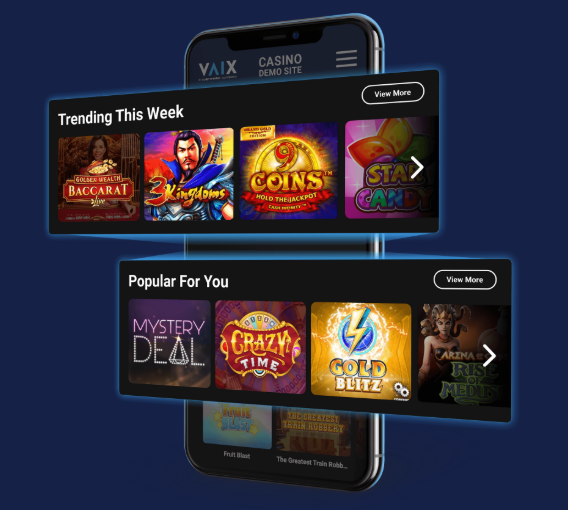Personalization and player retention: a match made in heaven
You can’t always get what you want,
But if you try, sometimes, well, you just might find
The Rolling Stones shared this wisdom in a song whose title matches its first line back in 1969. However, this notion loses its power if applied to the consumer side of our lives. Businesses have technical capabilities to predict customers’ wants and needs and are eager to deliver. Additionally, the purpose of personalization is to free consumers from the effort of searching for “the right thing.”
Personalization is about matching content, functionality, or experience to the needs and interests of specific users and presenting it at the right time to drive deeper engagement.
Adding a personal touch has become a standard business practice in numerous industries, from e-commerce and entertainment to healthcare, travel, and financial services.
I bet you’ve experienced, and not once, the perks of tailored suggestions when planning a trip, selecting the best-fitting music for your morning routine, or picking a new outfit from your favorite fashion brand. Take Spotify with their signature music mixes Discover Weekly, Blend, and Release Radar powered by ML models. Or Booking.com, the leading online travel agency that’s been in the personalization game since the 2010s, launching an AI Trip Planner a couple of years ago.
iGaming brands also introduce personalization to step away from the transactional nature of player interactions. It’s worth noting that marketing teams may adjust messaging for individual players and/or player segments. If recommendations and campaigns are refined for customer groups with similar traits, we are dealing with segmentation.
All aspects of player-brand relationships get transformed. Communications, lobby experience, and rewards undergo contextual relevancy checks.
Instead of bothering players with messages they might have zero interest in, operators ensure messages correspond to their preferences and past and real-time activity across target channels.
Content types that are commonly personalized include email newsletters, push notifications, paid media on the web and socials, and SMS. Push messages and SMS can be triggered in real time by behavioral events. For example, a player who’s just joined a casino stream to copy
bets behind a streamer can get a notification wishing them good luck. Another possible use case is showing a pop-up with a special offer to users who started but haven’t finished depositing funds.
Brands with sportsbooks may launch campaigns dedicated to specific events. Stake’s marketing team collaborated with Optimove’s Strategic Services during the Euro 2021 season. Optimove developed a tailored marketing plan that encompassed user segments, campaign ideas, and a posting schedule based on match timings. Key increases in marketing metrics included a 66% uplift in sport net revenue.
To maintain players’ attention for as long as possible and, that way, increase gaming session time, iGaming brands rearrange games in the lobby to show the ones a user is likely to choose.

Operators may nudge customers towards games that people with similar tastes enjoy. Systems may also consider real- or near-real-time activity data and suggest titles with attributes identical to those of a user who just played. In this case, recommender engines rely on game metadata.
One might follow Netflix’s lead and display thumbnails that players are expected to click on with the highest probability. To make such a prediction, the engine must analyze every aspect of the data on a player’s interaction with the website: history of played games, session duration, win/loss history, age, location (IP address), responses to promotions, and more.
Casinos tailor bonus structures to individual players based on gaming habits and spending patterns. For instance, operators can give free spins on a user’s favorite slots. Cashback bonuses may be adjusted based on recent losses (I call them consolation prizes). Another personalized incentive is a deposit match bonus — a certain percentage of a player’s latest top-up amount. We can say that casinos use tailored perks to balance players’ changing moods, weighing towards positive vibes when things go south.
Personalization helps users cut through choice overload and enables businesses to delight them with a bullshit-free experience. Consequently, companies may see significant improvements in retention, revenue, and customer base growth.
We’re spoiled with the variety and abundance of entertainment content, but having too many options might be overwhelming. Think of the last time you browsed a casino lobby or the Netflix homepage back and forth, trying to make up your mind. Hick’s Law in UX states the time it takes for a person to make a decision increases with the number of available choices. Recommendation engines come to the rescue, bringing the most relevant items for users based on their activity and tastes to the surface.
By helping users navigate options on the table and find new things, tailored suggestions can bring a sense of novelty to their experience. That’s critical for iGaming, where game types are limited. For instance, a change in a theme, sound effects, and pay lines from ancient Egypt (Queen of the Pyramids) to fruit and candy, like in Sugar Rush, can refuel a player’s fading interest in online slots.
Aligning content and features with users’ traits, interests, and pain points increases retention rates. Customers value it when businesses approach them with relevant offers and messages, and when the timing is right. This sentiment is universal. In 2021, McKinsey found that 72% of shoppers said they expected brands to know their interests and treat them as individuals, linking personalization with the positive experience of feeling valued. Positive experience with a business then leads to financial gains.
The ability to make accurate, personalized recommendations often translates into business growth. According to Boston Consulting Group, companies that use tailored marketing offers instead of generalized ones yield three times the ROI from campaigns. Spotify increased its customer base and revenue by 1,000% during the past 10 years. The music streaming giant reported user numbers were up 12% year-on-year and reached a record high of 675 million as of Q4 2024. Spotify made $4.7 billion in 2017; its current revenue is $17.48 billion. Impressive! Even this and last year’s decision to raise subscription fees didn’t affect revenue dynamics.
Incorporating personalization into user experience is paramount for success. However, Nielsen Norman Group experts warn that personalization should not be a remedy for a poorly functioning site or app. It’s like a final touch to a perfectly painted landscape or portrait; its role is to improve an already good experience.
“If users struggle to find information of interest on a site, the solution may not be to implement personalization or customization, but instead to fix the underlying site structure or even the content that is presented.”
Translating this advice to the iGaming world, ensure your players can enjoy their favorite games from any device, be it a desktop or a smartphone, easily find the section or feature of interest, and rest assured that their funds are safe. Once these requirements are met, time to introduce contextually relevant experience. You can do it!


